SoundBites
Winter 2023
Momentum Grows for Kinneytown
Dam Removal
Protecting Colebrook Reservoir

The Soundkeeper Experience
Decarbonizing Our Electric Grid
 s
Soundkeeper Bill Lucey (L) and CT State Representative Joe Gresko (R) after a successful trip gathering 60 abandoned lobster traps from the floor of the Sound.
s
Soundkeeper Bill Lucey (L) and CT State Representative Joe Gresko (R) after a successful trip gathering 60 abandoned lobster traps from the floor of the Sound.
with Leah: 2023 New York and Connecticut Legislative Priorities
Message from the Save the Sound president

Connecticut’s and New York’s legislatures are in full swing, and our expert crew is busy testifying at hearings, talking with legislators, and extending your voice to the halls of Hartford and Albany.
New York In November, an environmental investment vision became reality. Voters supported the Clean Water, Clean Air, and Green Jobs Bond Act by staggering margins. We look forward to helping move this $4.2 billion package into communities that need cleaner water, more resilient neighborhoods, and environmental justice. Now, we are busy meeting with lawmakers and allies, working on bill language, and keeping you in the loop on our priorities.
State Environmental Budget: Support for the Environmental Protection Fund at current levels and new appropriations for the Clean Water Infrastructure Act are needed for cleaner water; agencies need capital funding for the parks and natural spaces New Yorkers rely on.
Healthy Waters and Lands: Streams can mitigate flooding, protect water, and provide habitat—protections for Class C streams need strengthening.
Resilient Communities: Nature-based solutions like living shorelines protect homes and ecosystems. Home-buyers and sellers need better information about the flood and resilience potential of properties; requiring disclosures could protect both.
Connecticut The “long session” returned with continued opportunities for virtual engagement but better in-person access for advocacy. This session we’re focused on climate, plastics, and funding.
Healthy Waters: We are working to end polystyrene, balloon, and food container threats and forever chemicals like per- and polyfluoroalkyl (PFAS) that harm wildlife and our health.
Climate & Energy: Climate mandates are only as good as their enforceability; the Global Warming Solutions Act needs updating to require agencies evaluate and mitigate climate impacts of their decisions, and the public needs the ability to hold them accountable. We need more efficient
buildings and increased deployment of clean transportation.
Defending Laws, Lands, and Lives: We defend environmental laws against rollbacks and propel positive policies forward. Two that need momentum include strengthening CT’s Environmental Justice Law and meaningful participation in state land conveyances.
Environmental Budget: A clean Sound, green jobs, and local stormwater authorities require funding for environmental programs and the Clean Water Fund. Agencies need additional funding to keep enforcement strong and our parks healthy and accessible. To connect with legislative opportunities, email info@savethesound.org and we’ll set you up to receive action alerts.
Cheers to a more vibrant Long Island Sound region,
Leah Lopez Schmalz President, Save the Sound
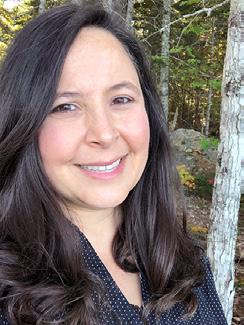
Kinneytown Dam Removal Project Recommended for Federal Funding
Advancing plan to return migratory fish habitat to the Naugatuck
(NOAA) Restoring Fish Passage through Barrier Removal grant program. NVCOG requested $15 million from the program earlier this year for a project that would include acquiring and decommissioning the facility, designing the deconstruction, and removing the dam and restoring the Naugatuck River.
The U.S. Department of Commerce announced on December 14 that the Naugatuck Valley Council of Governments (NVCOG), in partnership with Save the Sound, has been recommended for funding for a project which would lead to the removal of Kinneytown Dam in Seymour, CT. The funding will be available through the National Oceanic and Atmospheric Administration’s

Kinneytown Dam, a nonfunctioning hydroelectric facility on the Naugatuck River, has been a major barrier for migratory fish passage. In 2019, 2020, and 2021, Save the Sound and NRRG documented that hundreds of migratory fish were gathering and dying below the dam, unable to access habitat upstream. For the years 2000-2020, the average combined number of American Shad, Blueback Herring, and Alewife that annually passed the dam during the spring fish run was 12.5 individual fish per year.

“The Naugatuck River, which once flowed different colors each day, is getting significant attention from the federal government,” says Wildman. “This is exciting for me because my involvement in this river started over two decades ago, when I was a project engineer focused on removing five upstream dams. Being able to finally address the first barrier on the system with Save the Sound feels very fitting and fulfilling. Our entire organization, particularly our legal team, has been tirelessly advocating for successful fish passage at Kinneytown Dam for years. This funding ensures that this once industrial sewer will return to the life-supporting, swiftly flowing river that initially cascaded down the Naugatuck Valley.”
Next, Save the Sound and NVCOG will determine a scope of work with NOAA prior to receiving an official award.
Latest
Above: Kinneytown Dam, Seymour, CT
Read more: CT & NY agendas!
Colebrook Reservoir Protections Under Review
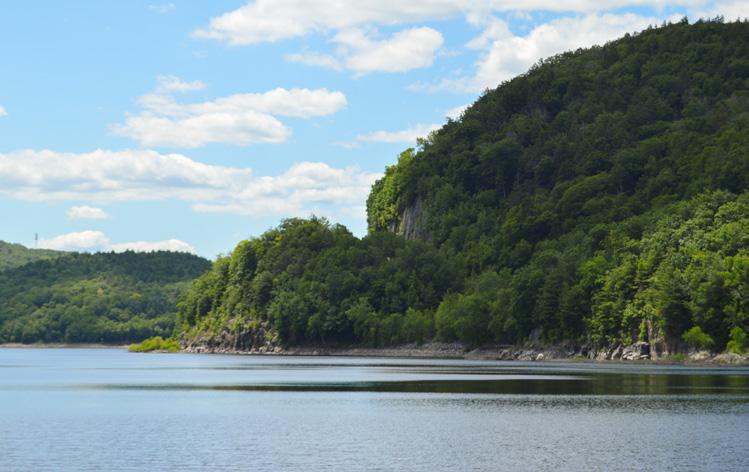
Save the Sound participates as intervenor at recent DPH meeting
Save the Sound is working to protect one of Connecticut’s last large, untapped surface public drinking water supplies, the Colebrook Reservoir, with 12,000 acres of surrounding forest. Metropolitan District Commission (MDC), the water company that supplies the Hartford region with drinking water, has rights to the 13.5 billion gallon (BG) supply and owns the surrounding forestland to protect the quality of the water. Upon its belief that this source is not needed for its customers and to eliminate related costs, MDC sought a declaratory ruling from the state Department of Public Health (DPH) that would allow MDC to unilaterally abandon 10BG of drinking water from the Colebrook Reservoir, a future and emergency supply, without going through an abandonment permit process. Save the Sound’s legal team has been following MDC’s efforts to
circumvent regulatory oversight to ensure that this land and drinking water are protected. We participated as an intervenor in a public hearing held at DPH in Hartford on January 5, but as of late January a final decision has not yet been reached.
If the decision favors MDC, it will impact protection of water supplies and forestland throughout Connecticut. The MDC decision could reduce its rights from 13.5 to 3.5BG through termination of a contract, thereby drastically reducing the drinking water supply available for future and emergency public use. Such a ruling would also allow other water companies to unilaterally abandon their unused water supplies and, in turn, eliminate legal
Scan for updates!

protections, including those for surrounding lands that remain undeveloped to protect drinking water quality. At Colebrook, 12,000 acres of water-filtering forest and wildlife habitat owned by MDC could become vulnerable to private development. Our intervenor petition stated, “It is contrary to both the law and smart environmental and public health planning to skip or eliminate this regulatory review.”
Donor Spotlight: Northport Yacht Club
The
road to becoming the most sustainable yacht club in Long Island Sound
Dedicated to understanding the health of waterways and what can be done to improve them, Northport Yacht Club strives to keep their members and the community informed. One way they have done this has been by hosting the Water Quality Presentation, which Save the Sound has spoken at many times. In tandem with this annual presentation, the yacht club has set its sights on becoming the most sustainable yacht club in Long Island Sound.
In 2019, Commodore Rich Boziwick gathered several members of the Northport Yacht Club together in Northport, NY, to propose running a sailboat race/regatta to raise money for a charity. Several organizations were considered but Save the Sound was the one that stood out. “In the end, we all agreed that Save the Sound was the best because it is an organization that directly works to maintain and improve our region’s water, which is at the heart of all we do as boaters,” said Janice Winter, chairperson of the Sustainability Committee. Northport Yacht Club successfully hosted two regattas in 2021 and 2022, raising several thousand dollars for Save the Sound, and they plan to host another regatta on July 23, 2023.
With this goal in mind, they implemented several programs in the last four years to focus on educating members, living a more sustainable life, and improving waterways. Thanks to their Sustainability Committee, two major initiatives have been implemented: planting a rain garden that filters 15,000

gallons of rain water before entering the harbor and setting oyster cages underneath the club’s floating docks, which filter water and, once the oysters are large enough, will be set out in Northport Bay to form a reef. The club has also eliminated single-use plastics, installed a water filling station, and created The Most Sustainable Sailor award. This award encourages the next generation of sailors by leading the way on sustainable practices and inspiring others to be true stewards of the water and environment. Northport Yacht Club looks forward to competing with other clubs, in sailing and swimming, to grow together and increase awareness of sustainability through education.
 Above: Colebrook Reservoir, CT
Above: Northport Yacht Club planting a rain garden near the harbor.
Above: Colebrook Reservoir, CT
Above: Northport Yacht Club planting a rain garden near the harbor.
The Essence of the Soundkeeper Experience
A lifelong calling to save the Sound
In a world of atypical workdays, this one was pretty typical.
Bill Lucey, our Long Island Soundkeeper, started Tuesday, Dec. 6, schlepping from his Connecticut home to Newport, RI, where he waited hours for a three-minute window to testify in front of the New England Fisheries Management Council (NEFMC). He felt it was important to attend the meeting in person to make his case for the Council to add the issue of river herring bycatch to its official list of priorities for 2023—a formality necessary for any matter to be included on an NEFMC agenda and to have resources dedicated to exploring a problem and its potential solutions.
Bill had to leave before the meeting got around to its public comment period. He needed to get back to finish rigging gear for an outing the next morning, a task that extended a long day well into the cold, rainy night.
That is the essence of the Soundkeeper experience. Part of the job is spent working with agencies, community leaders, and elected officials to shape policy that benefits Long Island Sound and all the species reliant on its health (including us). Another part is spent out on the water—perhaps helping haul ghost traps off the Sound floor
as part of the Long Island Sound Lobster Trap Removal and Assessment Partnership (L-TRAP) with The Maritime Aquarium at Norwalk and Project Oceanology, as he did the day after the Newport round-trip. It is the Soundkeeper’s mission to stand up for the Sound, whether his feet are planted on the deck of a boat or in the halls of state capitols.
“It’s a balance of being able to contribute in the rooms where decisions are being made and maintaining a field component, remaining close to the people of the Sound, to hear what they’re saying and learn from what they’re observing, to understand the perspective of the people who are out on the water all the time,” said Bill, whose work that December week typified the versatility required for his role. The L-TRAP outing that Wednesday removed 60 abandoned traps, and he did wind up testifying remotely on Thursday, shortly before the NEFMC voted to make river herring a priority issue.
The duality of the Soundkeeper job has been in its DNA from the start. The Long Island Soundkeeper Fund was founded in 1987 by Chris Staplefelt and Terry Backer, a lobsterman and environmental advocate who would go on to serve in the Connecticut
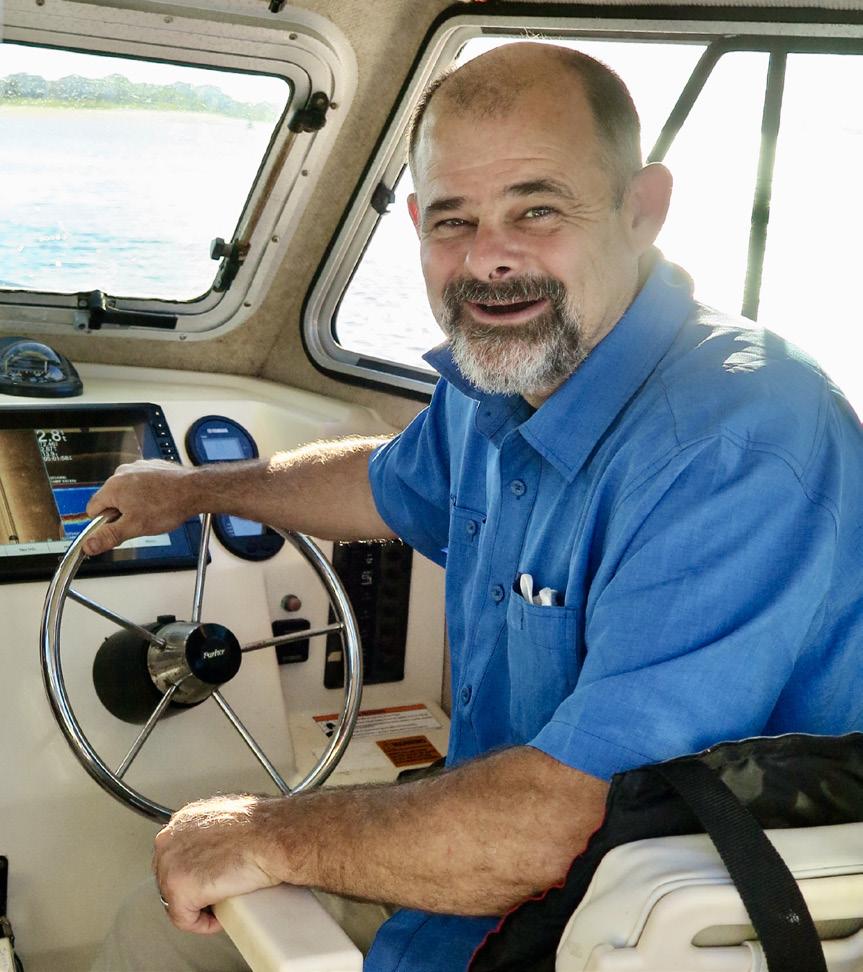
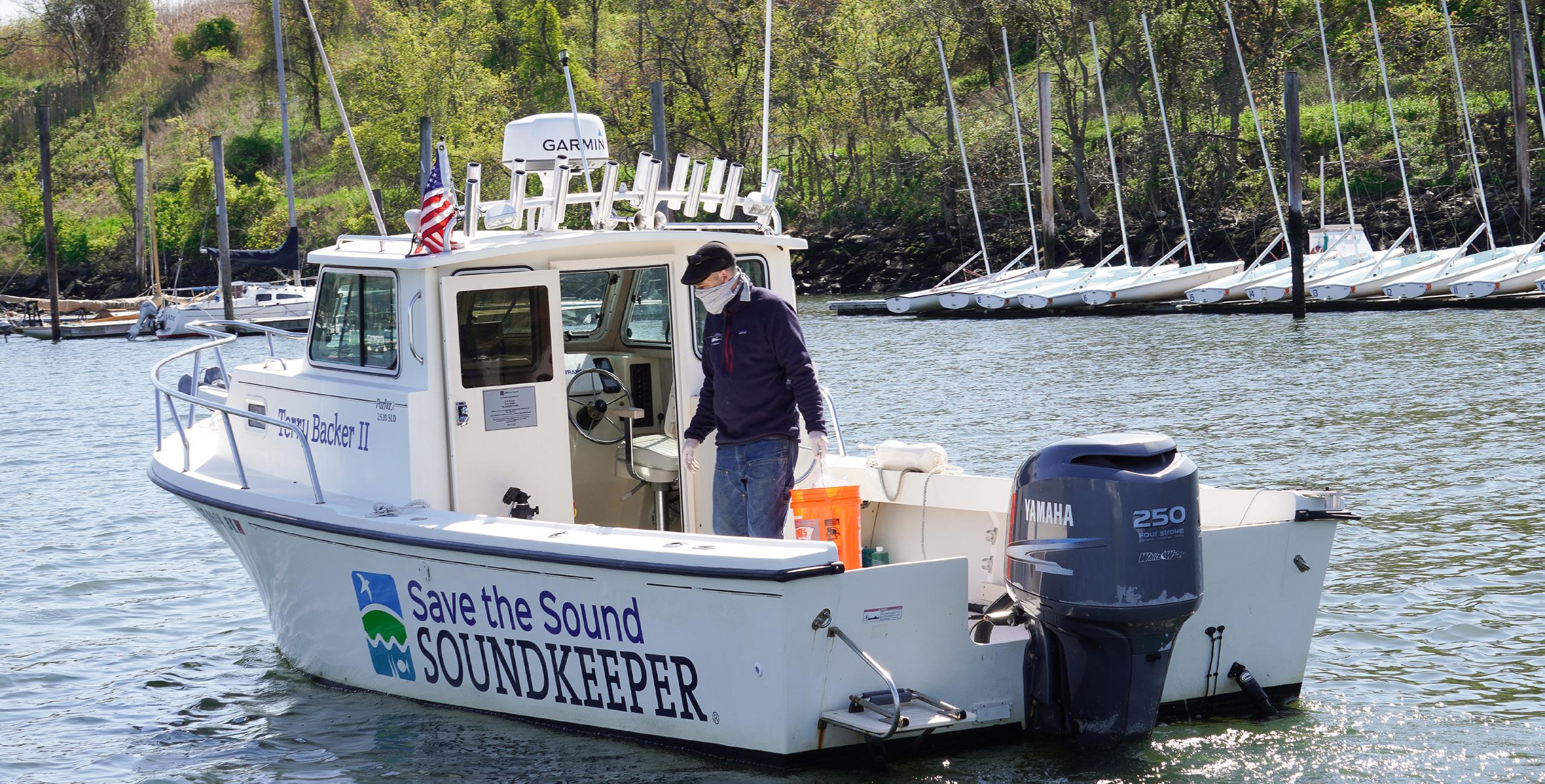
state legislature as the representative from Stratford. Backer, the original Soundkeeper, passed away in 2015. Bill was hired in 2017 as the new Soundkeeper, and the organization—an original member of the international Waterkeeper Alliance—merged with Save the Sound.
Bill, a fish and wildlife biologist whose introductory press conference was held at Brewer Stratford Marina on what would have been Backer’s 63rd birthday, was a natural choice to carry the torch. His path to the position may have wound through Vermont, Guatemala, Alaska, and Hawaii, but it began in Wilton, CT. The son of a father working on water-borne diseases in Africa for the U.S. government and the brother of a sister who conducted water quality testing in a local pond, it is unsurprising that Bill would wind up in a role that would have him mapping culverts along the shoreline of the Sound one day, and discussing shellfish aquaculture with Congressional representatives in the United States Capitol the next.
Helping save the Sound is a lifelong calling. “The idea behind Soundkeeper is that if you fish in or swim in or boat on a body of water,” said Bill, “you’re going to have a passion for and an interest in defending it.”
Soundkeeper Bill Lucey on the Terry Backer II
Your Eyes and Ears on the Sound
The Soundkeeper flag has been flying for 35 years, but that doesn’t mean everyone in the region knows what a Soundkeeper actually does.
“Some people ask me if I have the authority to give tickets. They think Soundkeeper is more of a police figure,” said Emma DeLoughry, who came aboard as Associate Soundkeeper in June, doubling the team’s presence on the water.

The Soundkeeper doesn’t police the Sound, per se, but it does patrol the waters, monitoring for potential sources of pollution along the 600 miles of encircling coastline. That’s a lot of leash for the region’s on-the-water watchdog.
“People also reach out with their pollution concerns,” Emma said. “Sometimes it’s a culvert on a beach that someone thinks is putting out sewage or dirty water, or they notice construction on private property along the coastline and they’re concern that debris is not being maintained or stored properly.”

The system works best when all stakeholders work together to resolve a pollution incident, as happened last September. Emma was out with representatives from the Black Rock Harbor Study and Ash Creek Conservation Association, collecting water quality samples
from a combined sewer overflow pipe discharging into the Pequonnock River in Bridgeport. The samples were processed at the John and Daria Barry Foundation Water Quality Lab in our Larchmont, NY, office, and showed the highest-possible levels for Enterococcus—indicative of untreated sewage entering the water. Emma alerted the Bridgeport Water Pollution Control Authority, which took immediate action: blocking the pipe right away, capping it permanently the next day.
“When people are more familiar with Soundkeeper and know what we do, it makes it easier for everyone to want to work together,” said Emma. “At the end of the day, we all just want to clean up the waterway.”
Grade Expectations: 2022 Long Island Sound Report Card
Making water quality data available for the entire Sound
How’s the water? It’s the question our water quality team is asked more often than any other. In November, we provided as comprehensive of an answer as we can with the release of the 2022 Long Island Sound Report Card.
The biennial Report Card evaluates the ecological health of Long Island Sound, providing data-driven grades for five open water segments of the Sound and for 53 bays and harbors along its margins. The Bay Grades stem from the work done in our Unified Water Study.
So...you may ask again...how is the water? The water quality in the Eastern and Central Basin once again received excellent grades. However, as you move further west into the Western Basin and Eastern Narrows—areas that span from Bridgeport, CT to the outer edges of New York City—the progress made over the past decade seems to have plateaued. The Western Narrows received an F, but as you can read in the Report Card, there actually are some early signs of hope and progress in the most urbanized and populated portion of Long Island Sound.
You can take a deep dive into the grades by downloading your own copy of the 2022 Long Island Sound Report Card at soundhealthexplorer.org or scanning the QR code below. Request a hard copy by emailing us at info@savethesound.org

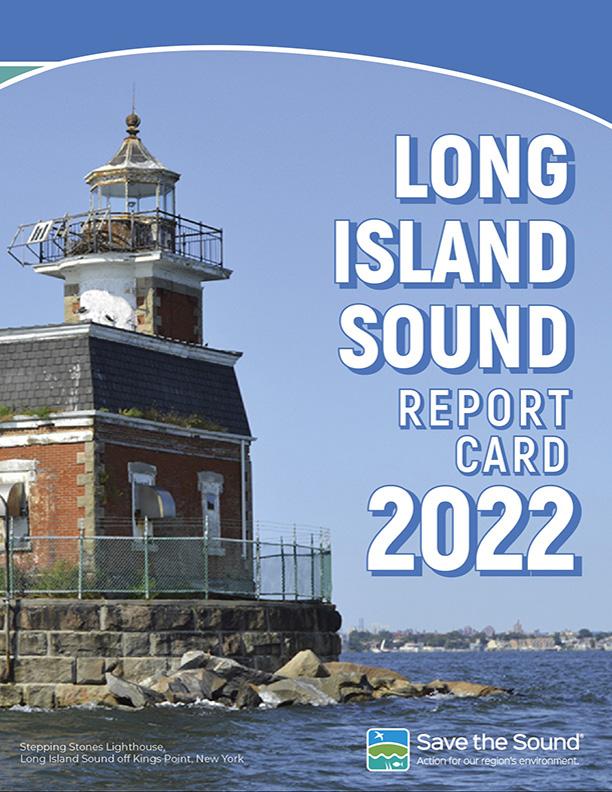 Meet Associate Soundkeeper Emma DeLoughry
Above: Emma DeLoughry on the Terry Backer II during an outing in Black Rock Harbor to collect samples.
Meet Associate Soundkeeper Emma DeLoughry
Above: Emma DeLoughry on the Terry Backer II during an outing in Black Rock Harbor to collect samples.
New Program
Leadership at Save the Sound
Grants Awarded for New York River and Shoreline Health
Blind Brook, Big Rock, and stream barrier evaluation receive funding

Attorney and environmental consultant Denise Stranko was welcomed to Save the Sound as the vice president of programs in October 2022. Based at the New Haven office, Denise directs and implements the organization’s strategic plan and serves as a primary voice for Long Island Sound and all the communities in its watershed. She also connects Save the Sound with new supporters, builds networks, partners with the philanthropy team, and serves as a member of the executive team. “Coming to Save the Sound gives me an opportunity to engage more meaningfully with issues in the region where I already live. Long Island Sound requires multi-state coordination along with a federal component. It’s interesting and impactful,” said Denise.
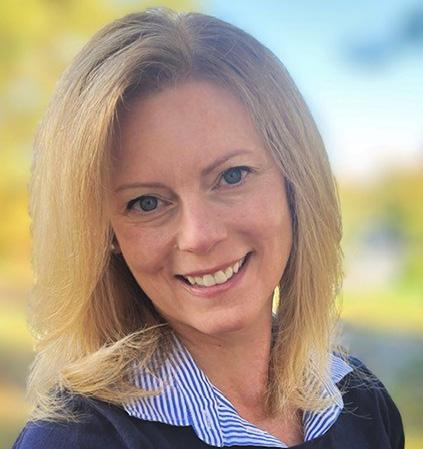
With more than 20 years of experience advocating for strong environmental laws and policies at both the federal and state levels, Denise’s areas of expertise include administrative law, appropriations, agricultural issues, and the Clean Air Act and Clean Water Act. In her most recent role as the Federal Executive Director at the Chesapeake Bay Foundation, she led her team, in partnership with a large coalition, to lobby for the successful reauthorization of, and an increase in funding for, the EPA Chesapeake Bay Program. After graduating from SUNY Albany, Denise earned her JD at Emory University and started her legal career as a litigator in private practice, later following her interest in the environment to the role of counsel in the Department of the Interior’s Office of Inspector General.
The latter part of 2022 was an exciting time for restoration projects in New York; three received state and federal funding to address river health and connectivity in Westchester County. Our dam reconnaissance study, aiming to assess the feasibility of dam removal for the first barrier on Blind Brook at Rye High School, in Rye, NY, was awarded $109,984 from the New York State Department of Environmental Conservation through the Marine Habitat Tributary Restoration and Resiliency Grant. The project is collaborative with the Rye City School District, Rye Sustainability Committee, City of Rye Conservation Commission Advisory Council, and Rye Nature Center, and the funds will support our effort to identify potential effects of removing the existing dam, locate upstream barriers to migratory fish, and conduct baseline water quality monitoring. This restoration effort will start in 2023.
Also in 2023, Save the Sound will be restoring three acres of salt marsh and 0.14 acres of oyster reef as a nature-based solution to erosion and rising sea levels in Queens, NY, where we’ve received a $2.38 million grant from the National Coastal Resiliency Fund, supported by the National Fish and Wildlife Foundation (NFWF) and the National Oceanic and Atmospheric Association (NOAA). This living shoreline project will help build the resiliency of the built environment while simultaneously providing critical habitat for local wildlife and supporting biodiversity in New York City and the Long Island Sound region. The restoration of this marshland area, known as Big Rock, is a collaborative effort with our partners at the Douglas Manor Association, Douglas Manor Environmental Association, Udalls Cove Preservation Committee, Hofstra University, New York City Audubon, and Billion Oyster Project.
Stream
Lastly, the Long Island Sound Study and NFWF have awarded $456,600 for our ecological restoration team to track and assess barriers to fish migration on rivers and streams in Westchester County to
inform stream restoration priorities and projects along riverine migratory corridors that connect to Long Island Sound. We are excited to start working on these impactful restoration projects next year!
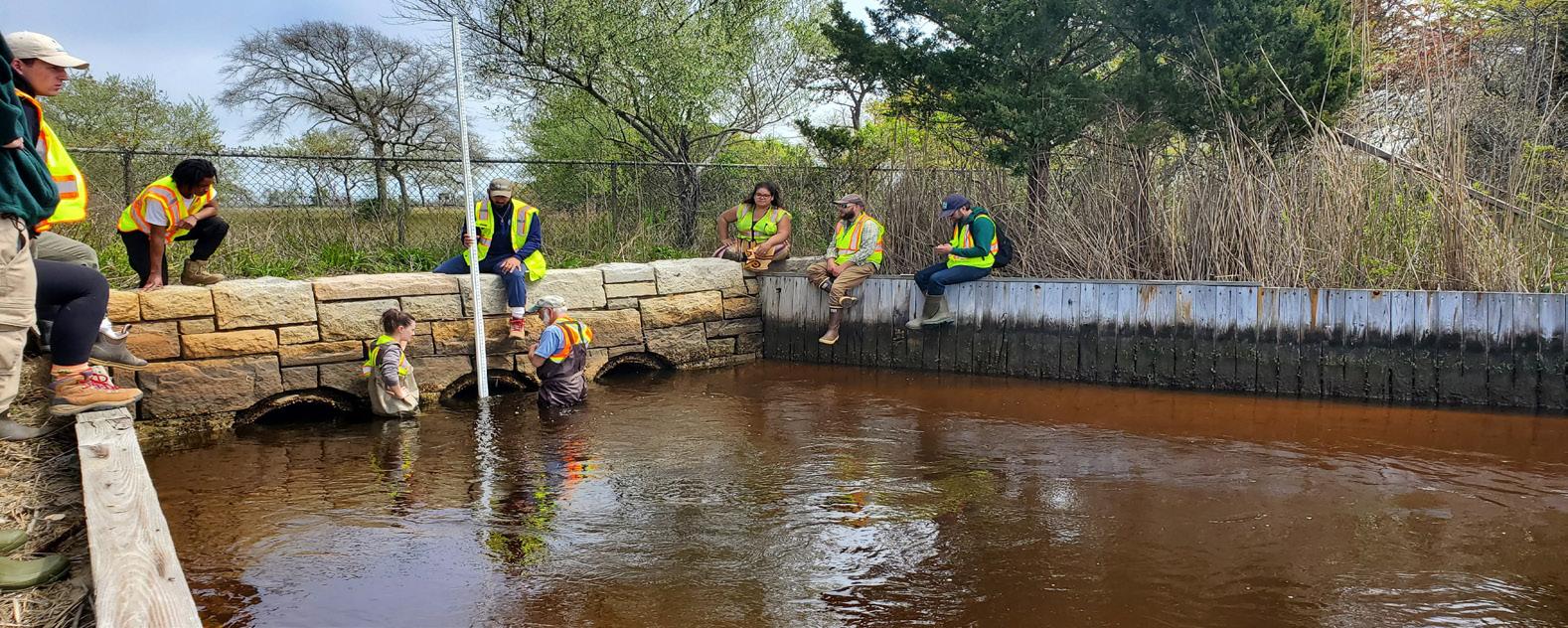
 Meet Denise Stranko, our new vice president of programs
Blind Brook
Big Rock
Barrier Evaluation
Meet Denise Stranko, our new vice president of programs
Blind Brook
Big Rock
Barrier Evaluation
Decarbonizing Connecticut’s Electric Grid
Advocating for energy equity at PURA
From purchasing an electric vehicle, to installing solar panels, to taking advantage of a battery storage system, there’s momentum at the Public Utilities Regulatory Authority (PURA), the state agency that implements energy policy. Our Climate Attorney Charles Rothenberger works in coalition and shows up in full force for docket hearings to ensure Connecticut residents benefit from a clean and energy efficient economy.
The Shared Clean Energy Facilities (SCEF) Program is steadily advancing clean energy opportunities for low-income customers and households in state-designated environmental justice (EJ) communities. Beginning in 2023, the program capacity will double from 25 Megawatts to 50 MW annually and any shortfall in one year will be rolled over into the following year’s capacity.
The Electric Vehicle (EV) Charging Program continues to evolve and improve, as PURA expands the residential managed charging incentive program into a year-round program (from a summer-only program). This program provides incentives of up to $1,000 for the purchase and installation of a networked EV charger, with recipients participating in a managed charging program that rewards customers for modifying their charging behavior at certain times to help reduce the load on the grid.
The Residential Renewable Energy Solutions (RRES) Program has also seen strong performance and is on track to approve 81.4 MW of residential projects in the first year of the program. Although overall performance has been strong, the program is falling short of achieving its

benchmark of 40% low-income customer and participation from customers from EJ communities. Beginning in January 2023, affordable housing facilities with individually metered customers will be able to participate in the RRES program with the financial benefit of the solar installation split equally between the tenants and owner.
More information on recent dockets can be found on our blog post “Connecticut Energy Dockets Update: Clean Energy Grew in 2022.” Our advocacy will build on this unprecedented momentum and we will continue advocating for energy equity and cleaner air.

Save the Sound Receives Empire Award from NYS Senator
Shelley Mayer
Partnering with New York towards a healthier Long Island Sound
“I wanted to acknowledge the work you have done, the leadership you have shown, the commitment to our community, broadly defined; I’m happy to see you’re in the Bronx and you’re in Connecticut, you’re all over,” New York State senator Shelley Mayer told our president, Leah Lopez Schmalz, and a gathering of Save the Sound staff in midDecember. “If it weren’t for you, I really don’t know who would be doing this work.”
Sen. Mayer visited our Larchmont office to present Leah with an Empire Award, recognizing Save the Sound for “outstanding contributions and dedication to the growth, prosperity, and betterment of their community and New York State.”
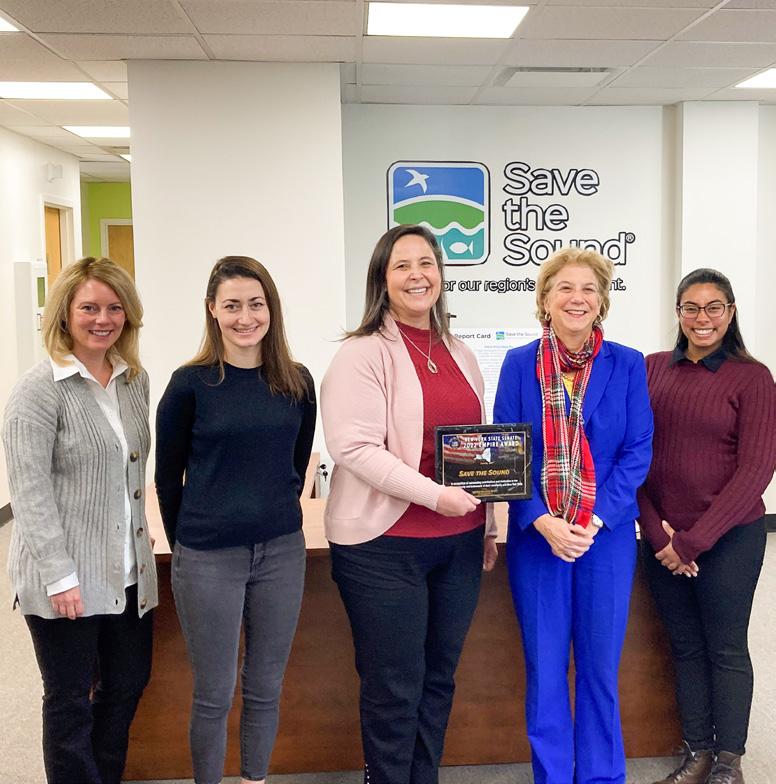
Leah, in turn, thanked the Senator for her working on living shoreline legislation that passed the state senate unanimously in 2022 (though it will need to be reintroduced in this year’s session), for “bringing the whole community together to talk about resilience,” and for her staff being “supporters of everything that Save the Sound does.”
After the pleasantries, the talk turned to the important work ahead, and to the opportunities to continue to work together toward a healthier Long Island Sound.
“Sometimes,” Sen. Mayer said, “the most important thing government can do is support the nitty gritty work that doesn’t get all the glamour. And what you do here really affects people’s lives.”
Above: Leah Lopez Schmalz (center) and Save the Sound staff accept award from Sen. Shelley Mayer (second from right).
A National Stage for Model Estuary Work

Staff participate in Restore America’s Estuaries conference
“Having the chance to present at a national conference with our partners, sharing our experiences, putting Long Island Sound on the national stage as it should be, obviously, is quite an honor,” said Peter Linderoth, our director of water quality, who presented on the Unified Water Study in a panel entitled “Long Island Sound: Science, Reporting, and Outreach Tools for Estuarine Management.”
Our Water Quality team got a taste of New Orleans back in December. But the highlight from their time at the Restore America’s Estuaries (RAE) conference had nothing to do with the tastes and sites of the Crescent City; it was all about the Sound.
Peter was joined at the RAE conference by Save the Sound President Leah Lopez Schmalz, Regional Directors Laura Wildman (ecological restoration) and David Ansel (water protection), Lab Manager Elena Colón, and Clean Water Advocate Sam Marquand.

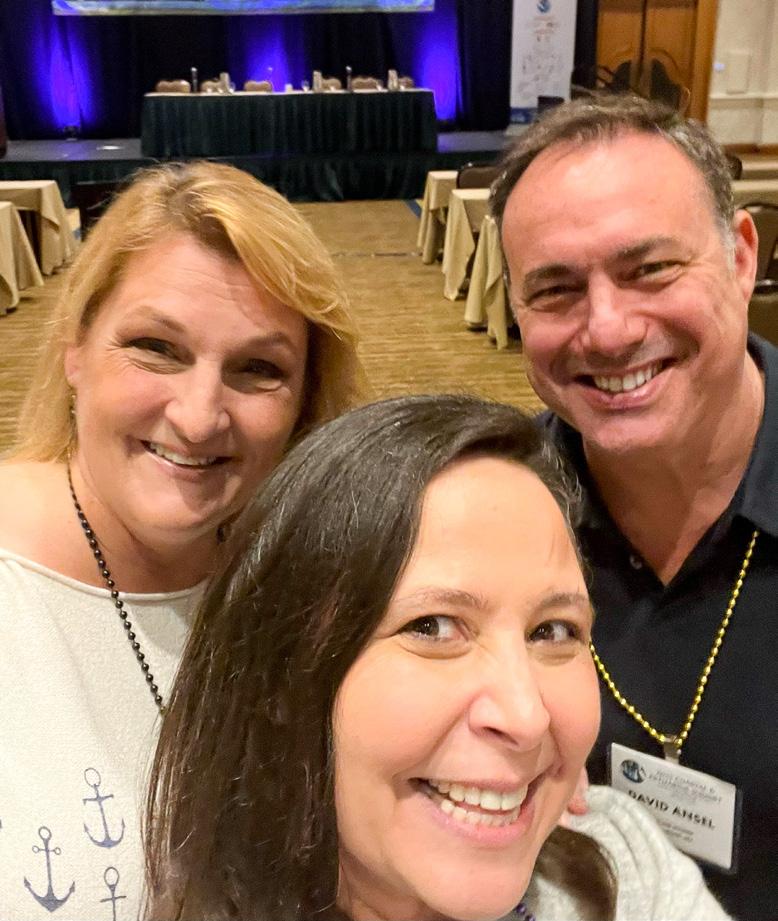
In this issue… Momentum Grows for Kinneytown Dam Removal Protecting Colebrook Reservoir The Soundkeeper Experience Decarbonizing Our Electric Grid 127 Church St, 2nd Floor New Haven, CT 06510 Non-Profit U.S. Postage PAID Permit No. 403 New Haven, CT
Published by Save the Sound. All rights reserved. • 127 Church St, 2nd Floor, New Haven, CT 06510 • 1385 Boston Post Road, 2nd Floor, Larchmont, NY 10538 • 203-787-0646 • ajames@savethesound.org Articles in this newsletter may be reprinted with permission. • Newsletter team: Amanda James, Laura McMillan, Alicia Sullivan, Michelle LeMere.
Above: Save the Sound staff and RAE President & CEO, Daniel Hayden (center rear).
Above: Laura Wildman (left), Leah Lopez Schmalz (center), and David Ansel (right)

 s
Soundkeeper Bill Lucey (L) and CT State Representative Joe Gresko (R) after a successful trip gathering 60 abandoned lobster traps from the floor of the Sound.
s
Soundkeeper Bill Lucey (L) and CT State Representative Joe Gresko (R) after a successful trip gathering 60 abandoned lobster traps from the floor of the Sound.








 Above: Colebrook Reservoir, CT
Above: Northport Yacht Club planting a rain garden near the harbor.
Above: Colebrook Reservoir, CT
Above: Northport Yacht Club planting a rain garden near the harbor.





 Meet Associate Soundkeeper Emma DeLoughry
Above: Emma DeLoughry on the Terry Backer II during an outing in Black Rock Harbor to collect samples.
Meet Associate Soundkeeper Emma DeLoughry
Above: Emma DeLoughry on the Terry Backer II during an outing in Black Rock Harbor to collect samples.



 Meet Denise Stranko, our new vice president of programs
Blind Brook
Big Rock
Barrier Evaluation
Meet Denise Stranko, our new vice president of programs
Blind Brook
Big Rock
Barrier Evaluation





